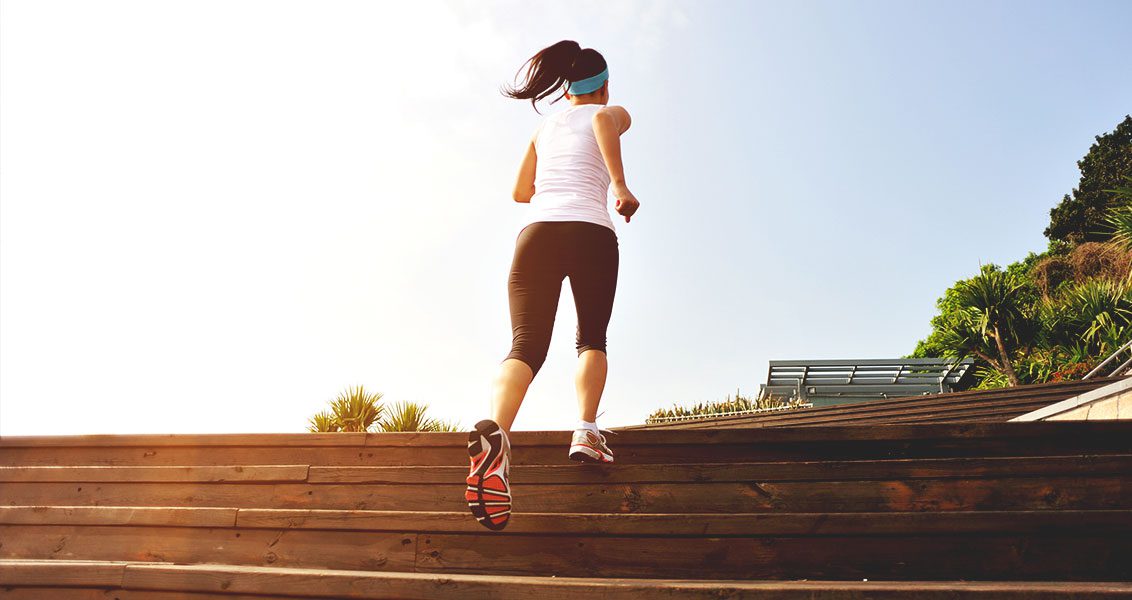
Two weeks before the start of my junior track season in high school, I flew to the Netherlands to visit my dad, who was working abroad at the time. And while I was stoked to see him—and Holland’s famous tulip fields—I was a bit nervous about how I was going to keep up my training regimen overseas. After all, I’d come to rely on hill workouts to build and maintain leg strength and endurance. And while Holland’s flatter-than-a-pancake terrain is great for leisurely bike rides along the canals, it’s not ideal for incline workouts. As I gazed out of my hotel window, pondering possible alternatives, my eyes locked on the four-level parking structure across the street. No—I wasn’t about to risk my life on the ramps (especially considering Europe’s reputation for speedy driving). Instead, I set my sights on the staircase located in the corner of the garage. That day, I did my first stair interval workout (and later, ate my first stack of fries covered in mayo). To this day, I still use stairs to substitute—and sometimes, even suppliment—my hill-training efforts.
Want to take your incline training to the next level—literally? Here are four ways to step your way to increased strength and stamina:
1. Run long intervals of multiple consecutive flights.
This is the equivalent of a long hill interval. You’ll need to find enough steps to run for at least a minute straight. Ideally, each repetition should last 90 seconds to 3 minutes, and you should do 6 to 10 total reps (with 30 to 90 seconds of rest between each interval). If slogging through a series of back-to-back long intervals doesn’t sound appealing, try mixing in some shorter sprint climbs or organizing your workout as a ladder (i.e., start with 3 minutes, then 2:30, then 2, and so on).
2. Run multiple isolated sprints.
“Sprint” might mean different things to different people, but in my mind, the duration of a sprint can range anywhere from 15 seconds to a minute. The idea is to go fast—like gasping-for-air-when-you-finish fast. As with any speed workout, you should definitely feel the burn during the last few seconds. To get the maximum benefit of this type of workout, you’ll need to give yourself enough recovery time that you can reach your top speed on the next rep, but not so much that you prevent fatigue from building. Now, there are two ways to approach your sprints (depending on the stairs you have to work with):
- Hitting every step on the way up. This requires shorter steps and faster turnover, which encourages fast-twitch muscle development.
- Stepping by twos (i.e., hitting every other step on the way up). This merges speed and strength training, as it requires you to recruit more muscle power as you make your ascent.
3. Integrate circuit exercises between stair reps.
If you want to add some depth to your stair workouts, try doing some core exercises or body weight lifts at the top. For example, you could bust out a set of 10 or 20 push-ups, go through a plank series, or use the stairs to knock out some dips.
4. Go vertical with plyometrics.
If you get bored with running flights of stairs—or you just want to target some different muscle groups—try adding a few plyo exercises to the mix. Here are a few of my faves:
- Single-foot hops: Standing on one foot, quickly hop on and off of the bottom step. That’s one rep. Shoot for 10-20 reps; then, work to increase your speed.
- Push-offs: With one foot planted on the ground, lift your other foot to the second (or, if the steps are short, third) step from the ground. With one swift, explosive motion, push your foot off of the step (both feet will leave the ground) and land softly in the starting position. Repeat 10-20 times on each leg.
- Double-foot continuous hops: Use two feet to jump from one step to the next until you reach the top of the flight/staircase.
Remember, stair workouts should be just one component of your speed and strength training program. Overdoing it could lead to injuries (like shin splints). To keep yourself injury-free—or to expedite your recovery from a current injury—consider booking an appointment with a physical therapist (PT) in your area. No one knows the musculoskeletal system better than a PT—and if you’re looking to maximize your athletic performance, there’s no better pro to enlist as your partner. As for me—I ended up winning three state track and field titles the year I discovered stair workouts. But even if you don’t have your sights set on the top of the podium, these exercises can help take you to the top of your personal fitness game.


